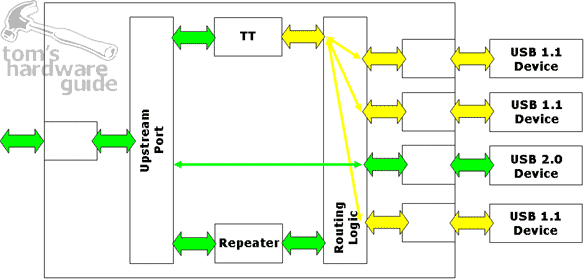USB Technology: Multi-TT Hub Goes Head-to-Head With Single-TT
Single TT Or Multi TT
One way to solve the problem is to increase your total bandwidth by plugging the USB 1.1 devices into a USB 2.0 hub.
All USB 2.0 hubs have at least one built-in transaction translator (TT) so that they can be downwards compatible. The TT automatically recognizes which USB category is connected on a particular port and translates any USB 1.1 signals to USB 2.0. There is a catch: you only have one TT for all your available ports, which keeps the bandwidth to the system down to no more than 12 mbit/s.
Overall performance suffers whenever all the devices on the hub have to share one transaction translator.
You can get around this problem by using higher-quality USB hubs that have as many TTs as they do ports. No longer do the devices on the hub have to wait their turn for some free bandwidth; the TTs optimally embed all the separate data streams in the USB 2.0 data stream.
Each port in this hub has its own transaction translator. Only three are in use, though: a USB 2.0 device is connected to the fourth port, and its data doesn't need to be translated before being transferred.
Get Tom's Hardware's best news and in-depth reviews, straight to your inbox.
Current page: Single TT Or Multi TT
Prev Page Universal Serial Bus: ABC Next Page Standard Hub With One TT: DLink DUB-H4
Patrick Schmid was the editor-in-chief for Tom's Hardware from 2005 to 2006. He wrote numerous articles on a wide range of hardware topics, including storage, CPUs, and system builds.
-
I am having a really hard time resolving this issue on a brand new Asus desktop machine with the Asus motherboard P8H61-MX. It seems that Asus have cut a corner or two and only included a single TT setup on the motherboard which has 6 inbuilt USB ports. I am having real difficulty finding a PCI express USB card here in the UK which actually has a built in Multi TT setup. My Novation NIO 2|4 soundcard and my Vestax VCI-100 midi controller fail to function without multi TT, and if anyone has any advice it would be appreciated.Reply
David

